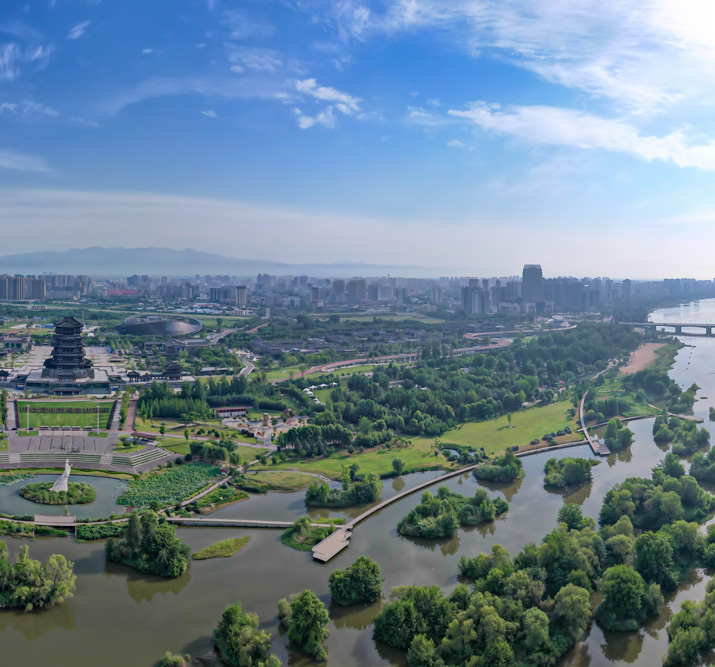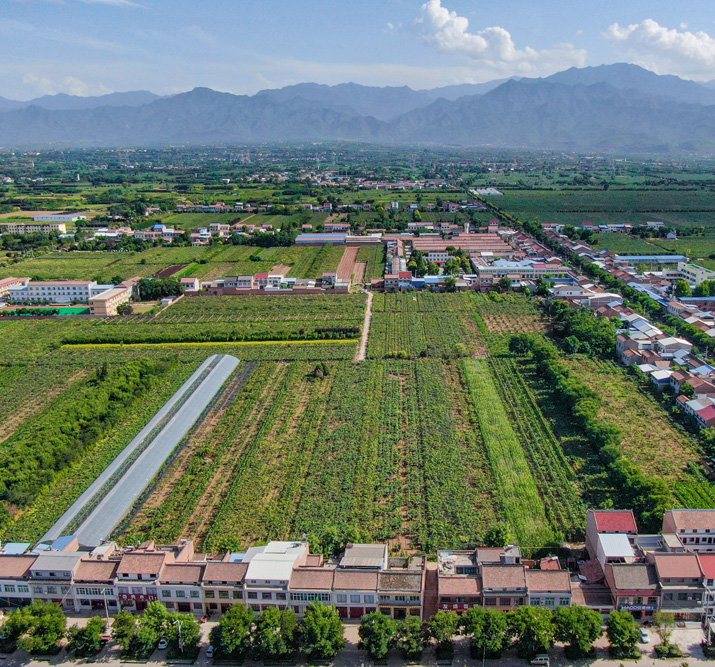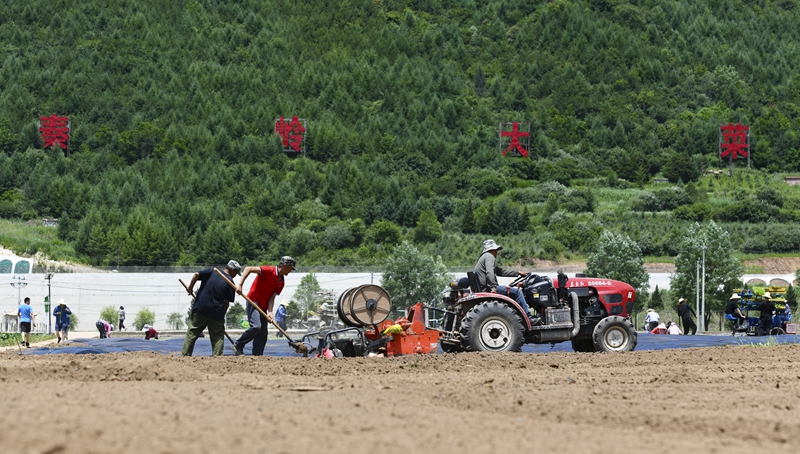
A wetland park in the center of Hanzhong City, Shaanxi province, on June 24 (XINHUA)
In his novel Ordinary World, Shaanxi-born writer Lu Yao depicted his hometown during the 1960s as a sandy and barren area, lacking water and vegetation, and plagued by frequent harsh winds. He celebrated the diligence and wisdom of the people living in this challenging environment.
Located in northwest China, Shaanxi Province to this day is often described as having "waves of yellow mountains." This environmental and geomorphic feature resulted from the combination of its inland location, minimal rainfall, and soil and water erosion due to the flow of the Yellow River. The province also endures intense heat from strong sunlight.
In recent years, Shaanxi has seen big changes.
Efforts have been made to increase plant coverage and optimize the use of water resources. Additionally, the region has embraced solar energy, using it as a clean and cost-effective power source.
A green solution
"We hope to maximize the benefit of every beam of sunlight with photovoltaic (PV) technology," Li Zhenguo, President of LONGi Green Energy Technology Co. Ltd, a leading local PV company, said.
Headquartered in Xi'an, capital of Shaanxi, LONGi was founded in 2000 and has since become the world's largest manufacturer of monocrystalline silicon solar panels. These panels are a direct application of PV technology, which converts sunlight into electricity.
The company's main business segments further include battery modules, green energy and hydrogen equipment. LONGi plays a big part in the development of green energy in Shaanxi.
LONGi has contributed to the popularization of PV infrastructure in Shaanxi, reducing carbon emissions and promoting green ecological development.
In June 2022, the company introduced the Sunflower Plan, a subsidy program designed to facilitate the installation of PV systems for rural households in Shaanxi. As of late 2022, the program covered almost half a million households in the province.
In June 2023, after LONGi launched this initiative, it also set up a pilot project utilizing PV technology for rural revitalization in Kefang Village, Tongchuan City, Shaanxi.
China's rural revitalization, a strategy introduced at the 19th Communist Party of China (CPC) National Congress in 2017, aims to promote the economic prosperity and overall development of rural areas. It builds on the success of the nationwide poverty alleviation campaign that had eradicated absolute poverty as of late 2020.
By the end of 2023, LONGi's pilot project had successfully reached 108 households in Kefang Village. These households are projected to generate 3.81 million kilowatt-hours (kWh) of power annually, on average, resulting in an average yearly revenue of 1.352 million yuan (approximately $190,000). This translates into an average annual income exceeding 10,000 yuan ($1,373) per household, paid directly to the villagers, according to a LONGi news release.
"Unlike Europe [where the PV industry mainly targets residential consumers and industrial and commercial sectors], China's PV industry targets farmers, who are often hesitant to take out loans to set up PV infrastructure. So LONGi provided low-interest loans and shared 80 percent of revenue with the households, promoting green energy and increasing people's income," Jiang Dongyu, Vice President of LONGi, explained.
Since 2021, boosted by supportive policies from the provincial and local governments, rural PV projects have expanded across Shaanxi. In 2023, these projects generated over 1.438 million kWh of electricity, a 28.9-percent increase from the previous year.

The Kiwifruit Special Agriculture Base of Meixian County in Shaanxi on June 25 (XINHUA)
The greener lands
In addition to taking advantage of solar energy, Shaanxi is also stepping up efforts to tackle environmental problems, making the place much more hospitable and actively nurturing its economic growth potential.
In Yulin, Shaanxi's northernmost city bordered by Inner Mongolia Autonomous Region, 53 rivers flow into the Yellow River, causing a significant amount of soil erosion and resulting in arable land scarcity.
Yulin has enhanced its land utilization and increased water retention by constructing terraces and planting forests.
"Initially, we constructed dams in the ditches to mitigate soil erosion from the Yellow River floods, which proved somewhat effective. However, these dams were soon destroyed by larger floods. So we opted for horizontal terraces on the milder mountain slopes to slow the floods, allowing the dams to retain the remaining water and soil," Chang Jing, Secretary of the CPC Branch of Gaoxigou Village in Yulin told newspaper Economic Daily.
Yulin has implemented water-saving agricultural practices utilizing advanced technology. In Gaoxigou Village, PV power is used to elevate water from ditch dams to storage cellars and targeted drip irrigation systems have been employed to replenish water in lower-lying fields. These measures address water shortages during critical growth periods of crops.
The initiatives have not only boosted agricultural production and protected the environment but also increased farmers' incomes. In 2023, the village's per-capita disposable income reached 23,470 yuan ($3,224), higher than the national average of 21,691 yuan ($2,981) for rural residents in that year.
Modern concepts and technology were also adopted to upgrade the local ecosystem. In Hanzhong, a city in southwestern Shaanxi, the local government transformed extensive sandbanks into a sprawling wetland park stretching more than 10 km.
This transformation, inspired by the "sponge city" concept, now supports an ecosystem that is home to more than 30 fish species and 90 bird species, alongside over 300 types of plants.
"We observed more than 4,000 black-headed gulls in the wetland park this winter, compared to only dozens in previous years," Lei Jing, the deputy director of an office in charge of protecting the river and lands in Hanzhong, told newspaper Science and Technology Daily. "We took advantage of the Hanjiang River's natural course to build the park, and now the park also serves as an ecological protection zone for the river."
The Hanjiang River is the longest branch of the Yangtze River, the longest river in Asia and the third longest in the world, flowing through southern Shaanxi.

Farmers work in a vegetable field in Baoji, Shaanxi Province, on June 25 (XINHUA)
Green to 'greenback'
With the implementation of green projects and energy initiatives, coupled with government efforts to introduce advanced agricultural technologies, crops previously unsuited for Shaanxi have thrived recently, boosting local incomes.
The province's Meixian County, renowned for its high-quality kiwifruit production, traditionally used flood irrigation, which was inefficient given the region's water scarcity and the vines' constant need for water due to persistent sunlight.
By the late 2010s, Meixian had adopted precise drip and sprinkler irrigation systems, enhancing irrigation efficiency.
Li Shengli, a 58-year-old kiwifruit farmer, told newspaper Guangming Daily, "The kiwifruit's root system is so fragile that it can be easily damaged by soil fissures caused by traditional watering techniques, leading to increasingly dry and barren soil over time."
The adoption of advanced irrigation technologies has made local farmers more conscientious about safeguarding their fields.
Over 80 percent of the per-capita disposable income in Meixian now stems from the local kiwifruit industry, earning the county nationwide recognition as "the kiwifruit specialty county."
Technological innovations have enabled many places in Shaanxi to produce higher-quality agricultural products. In Luochuan, traditional apple varieties are being replaced with those grown on dwarf trees. Although these trees produce higher-quality apples, they require more water and fertilizer during the growing process.
"During the 1980s and 1990s, the apples in Luochuan were primarily 'ordinary' ones [growing on standard-sized apple trees], because the irrigation technology wasn't advanced enough to meet the needs of dwarf apple trees; but now, we are gradually promoting the latter," Li Xiangqian, the director of an apple industry research center, said, adding that the research center is continuously tracking the latest progress in related technology.
Established in March 2019, the center has four apple-related research branches, aiming to improve the quality of Luochuan's apples.
Li explained how water pools and bumps have been constructed outside the apple orchards, along with drip irrigation equipment within the fields.
This setup ensures a consistent and adequate water supply for the apple trees. The drip irrigation system delivers water directly to the roots deep within the soil, a target area that other irrigation methods fail to reach effectively.
"The whole process is highly automated and digitized now. It takes only 15 minutes for one person to irrigate 6.67 hectares of apple trees through an app," Li added.
Shaanxi's flourishing agricultural industry has boosted the province's economic development, attracting young people originally working in the more developed eastern part of the country to return to their hometowns.
Among those returnees are Lin Sijia and her husband, who now run an agricultural service center in Meixian, offering local farmers testing, evaluation and training services. With the rise of the local kiwifruit industry, their business now has four branches located across the county.
Lin said, "The first time I saw the vast expanse of kiwifruit orchards stretching to the horizon, I felt confident about the future of the local kiwifruit industry."
And with crowds of fruit farmers in their 60s flocking to their center for consulting and training programs, the couple had no doubts they'd made the right decision. "We (my husband and I) decided to continue our careers in our hometown and contribute to the development of this industry."














